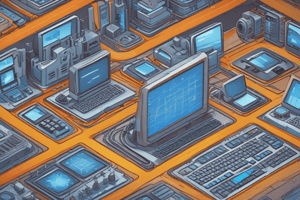Podcast
Questions and Answers
What is a key feature of large scale computing that differentiates it from basic software applications?
What is a key feature of large scale computing that differentiates it from basic software applications?
- Usage of simple network architectures
- Reliance on Microsoft Office
- Extensive hardware infrastructure (correct)
- Manual handling of maintenance tasks
Which of the following types of computers is primarily used by large organizations for critical applications?
Which of the following types of computers is primarily used by large organizations for critical applications?
- Personal computers
- Servers
- Mainframes (correct)
- Supercomputers
What technology is NOT typically associated with the robust IT infrastructure management in large scale computing?
What technology is NOT typically associated with the robust IT infrastructure management in large scale computing?
- Load balancers
- Automation techniques
- Content Delivery Networks (CDNs)
- Manual troubleshooting (correct)
Which aspect of IT infrastructure significantly impacts modern business operations?
Which aspect of IT infrastructure significantly impacts modern business operations?
What constitutes the essential components of IT infrastructure?
What constitutes the essential components of IT infrastructure?
What characteristic is most associated with supercomputers?
What characteristic is most associated with supercomputers?
Which of the following illustrates an example of infrastructure involved in economic activities?
Which of the following illustrates an example of infrastructure involved in economic activities?
What role does technology play in modern businesses according to the content?
What role does technology play in modern businesses according to the content?
What is included in a water supply system?
What is included in a water supply system?
How does small-scale computing differ from larger systems?
How does small-scale computing differ from larger systems?
Study Notes
Introduction to IT Infrastructure
- Covers fundamental concepts of IT infrastructure over 9 lectures.
- Key topics include networking, cloud computing, security, and privacy.
Definition of Infrastructure
- Infrastructure encompasses essential physical and organizational structures needed for society and enterprise operations.
- Important elements include transportation networks, electric grids, and water supply systems.
Importance of IT Infrastructure
- IT infrastructure is crucial for developing, testing, delivering, and managing IT services.
- Technology enhances communication and productivity in modern business operations.
IT Infrastructure: Small vs. Large Scale
-
Small-Scale Computing:
- Limited hardware for local networking.
- Basic software applications like Microsoft Office.
- Minimal maintenance tasks handled manually.
-
Large-Scale Computing:
- Involves data centers with numerous servers and extensive storage.
- Incorporates complex networking technologies and sophisticated software systems like ERP and big data analytics.
- Automation enhances management and monitoring capabilities.
Role of IT Infrastructure in Business and Everyday Life
- Businesses depend on IT infrastructure for communication, operations, and data management across industries.
- Everyday occurrences like online shopping and remote work rely on robust IT systems.
Types of Computers in Large Computing Environments
-
Supercomputers:
- Highly powerful for processing large data sets.
- Uses parallel processing for high-speed performance.
-
Mainframes:
- Used by large organizations for critical applications and bulk data processing.
-
Server Computers:
- Provide services to clients over networks.
- Include blade, rack, and tower servers focusing on performance and space efficiency.
Purpose and Benefits of Servers
- Servers manage centralized resources, enabling ease of administration.
- Facilitates secure data storage and sharing with reliable access to applications.
- Enhances security and provides scalability to accommodate business growth.
Understanding Clients
- Clients are devices or software that request services from servers.
- Function includes initiating communication, consuming resources, and enabling user interactions.
Components of IT Infrastructure
- Hardware: Includes computers, servers, storage, and networking devices.
- Software: Operating systems and applications power hardware operations.
- Facilities: Physical locations equipped with networking cables and systems.
- Networking: Elements like switches and routers enable device communication.
- Data Centers: Dedicated facilities housing servers and storage, often providing cloud services.
Datacenter Considerations
- Designed to securely host numerous servers with considerations for power supply, cooling systems, and redundancy to prevent downtime.
Network Applications
- Communication Tools: Including email, instant messaging, and video conferencing for business collaboration.
- File Sharing: Through cloud storage and collaboration tools like Google Docs.
- Web Services: Enables web browsing, e-commerce, and streaming services.
- Social Networking: Platforms for connecting (Facebook, Twitter) and communities (Reddit, Quora).
- Remote Access: VPNs and remote desktop services facilitate secure control and maintenance of computers.
- Internet of Things (IoT): Smart home devices and wearables enhance connectivity and automation.
Transition from Small to Large IT Infrastructure
- Evolution reflects growing technological demands, requiring scalable IT solutions for varying organizational sizes.
Studying That Suits You
Use AI to generate personalized quizzes and flashcards to suit your learning preferences.
Related Documents
Description
This quiz covers the fundamental concepts of IT infrastructure, including computer networks, internet workings, and business applications. Topics like cloud computing and security protocols are also addressed. It is based on the first lecture of the CS112 course, providing a comprehensive introduction to these essential topics.




